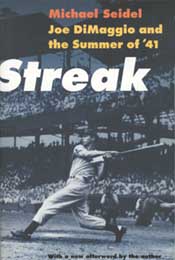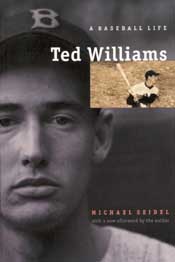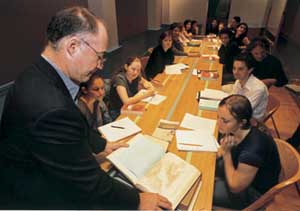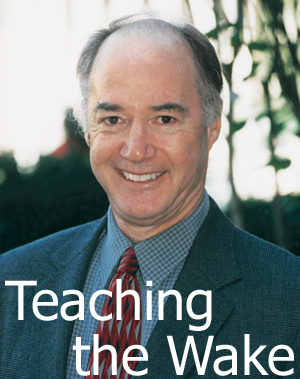|
|
 |
 |
 |
 |
|
COVER STORY |
|||||||||||||||||||||||||||||||||||||||||||||||||||||||||||||||||||||||||
|
|
When undergraduates asked for a course on Finnegans Wake, Seidel eagerly obliged - and has been thrilled with the results. |
During that time, Seidel has written biographies of Williams and his New York Yankee counterpart, Joe DiMaggio, and while he acknowledges that he doesn’t know of any other English professors who have written popular books about baseball, he downplays the uniqueness of being an expert in realms with no discernible overlaps (it is unclear if Joyce could hit a curveball, for instance).
“When you’re interested in something, the way you’re interested — that drive, that passion — is shaped in similar manners,” Seidel says. “I am simply going to give both subjects my attention, and I am grateful that I am able to teach Joyce while writing books about baseball.”
Seidel, 59, was born in New York City and received his undergraduate and graduate education at UCLA. In 1970, he joined the faculty at Yale, and seven years later, he moved down I-95 to set up shop in Columbia’s English department.
|
|
 |
| Seidel's passion for
baseball is evident in his profiles of Hall of Famers Joe
DiMaggio and Ted Williams. |
“It was a great job, and I wanted to be in New York City, which I preferred to New Haven, as well as to have access to Columbia students, who possess a particular type of inquisitiveness that is unique even among great universities,” Seidel says. “And, of course, Columbia had a renowned English department that I was eager to join.”
Another selling point for Seidel was that Columbia, under the direction of Professor William York Tindall, had become a center of Joyce studies and boasted a large collection of his works in the Rare Book and Manuscript Library. Though Seidel spent his first decade on the Heights primarily teaching courses on 18th century literature and the advent of the modern novel, he was given the opportunity to tackle Joyce in 1992 when Professor Wallace Gray, another famed literature scholar, retired, leaving his popular “Joyce, Eliot and Pound” literature class up for grabs.
Seidel jumped at the chance, and, after unceremoniously dismissing Eliot and Pound from the course, began offering a Joyce lecture that, despite the difficulty inherent in reading any of the Irish author’s works, quickly became one of the largest and most popular classes in the department.
While Dubliners, Portrait of the Artist as a Young Man and Ulysses were read, digested and debated by voracious undergraduates, one book remained out of reach for even the most passionate Joyce students. Finnegans Wake, Joyce’s final effort, was completed in 1939 after 17 years of work and just two years before the author’s death. Its so-called plot, if its wandering narrative can be deemed that, was borrowed from an old-fashioned — and deceptively simple — Irish-American comic ballad about an expatriot Irishman named Finnegan who dies after falling from a ladder while laying brick sand. And then, as all of his friends and family have a rousing time drinking and gossiping at his wake, he decides to get out of his coffin and join the fun.
“It is a remarkably fascinating book,” Seidel says. “It’s about, well, everything. Everything about the human condition and the human imagination that could be in a book is in this book.”
|
|
 |
According to Seidel, the book has some central themes that must be kept in mind in order to comprehend it. For instance, Finnegan’s plunge from the roof represents the fall of man, with man’s resurrection foretold in the Irishman’s rising from the coffin, with all of the guilt and strife that accompanies it. The emotions and actions of a man who stands in for Finnegan named HCE (or “Here Comes Everybody”), a wife, twin sons and a daughter encompass those feelings familiar to people throughout the world: love, betrayal, adultery, rivalry, guilt and hope.
The book is undoubtedly a classic. It also is extremely challenging.
“It is very, very difficult,” Seidel says. “It is 628 pages, and not one sentence is constructed out of clear prose. What makes Finnegans Wake so laborious is that Joyce intended it to not just be a book, but to be an encyclopedia of language.”
The book incorporates words, songs, and phrases from 40–50 languages, twisting and turning them so they at least appear to be in English, which gives each sentence and even every word multiple meanings.
Joyce was inspired to write in this manner after reading Through the Looking Glass, in which Humpty Dumpty told Alice about “Jabberwocky,” a way of speaking in which parts of words combine to carry more than one definition. To illustrate this, Seidel turns to a phrase that appears about two-thirds of the way through Wake thatn mentions a neighborhood very familiar to those who bleed Light Blue: “The line, ‘Toun of Morning de Heights with his lavast flow and his rambling undergroands,’ is a reference, clearly, to Morningside Heights, Columbia’s neighborhood,” Seidel said, “and ‘undergroands’ is a word that could refer to its subway, as in ‘rumbling underground,’ or its students, as in ‘rambling undergraduates.’
|
|
"The Wake seminar is why I chose Columbia... This course and this professor, if it hasn't happened already, are going to become legends on campus." |
“Every sentence is like this,” Seidel continues with a laugh. “So you can see why it takes some time to read this book. It’s an adventure.”
Despite its intimidating composition, one brief selection from Finnegans Wake was assigned to Seidel’s Joyce lecture courses. To the professor’s surprise, his students wanted more.
“The students from a large lecture wanted to tackle the Wake in a classroom setting; they wanted a 16–20 person seminar,” Seidel recalls. “It is simply unprecedented, and I did not think it was possible. The class, which started in the fall of 2001, is truly an experiment by bright and daring students.”
In order to qualify for the seminar, students must first take the Joyce lecture course, and then they must be prepared to read the Wake in its entirety. In lieu of lengthy papers, they are asked to compose a weekly journal entry on a passage that confuses or excites them, an assignment that Seidel says has produced “some of the best writing I’ve ever read at either Columbia or Yale.
“It’s been an amazing success,” he continues. “I simply didn’t imagine it could have happened in an undergraduate setting, and I’m happy to report that I have been proven wrong. The students’ young minds are still flexible enough to handle the Wake and all of its challenges.”
Seidel’s students are equally as pleased to finally have the chance to fully explore Joyce’s most demanding work. “I’ve never encountered anything like Finnegans Wake in all of my studies in literature. The book is virtually a continual exercise in the English language,” says Evridiki Poumpouridis ’03, an English major from Queens. “Reading Joyce is like taking a walk through an amusement park’s hall of mirrors, where the same figure is constantly reflected and refracted in thousands of ways. It’s just fun to read.”
“I love the intellectual freedom possible in the Wake seminar,” says Kate Kosloske ’03, a classics major from Alexandria, Va. “Professor Seidel wants us to play with the words and themes of the book, and it is clear that he, a great and passionate teacher, is as unabashedly a fan of Joyce as the rest of us are.”
“The Wake seminar is why I chose Columbia ... a great professor teaching a difficult — some might say graduate — seminar to a bunch of undergraduates, in a setting where you can exchange ideas and learn,” says Jeffrey Kallenberg ’03, a writing and literature major from Brooklyn. “This course and this professor, if it hasn’t happened already, are going to become legends on campus.”
|
|
"I am constantly challenged, and I'm always learning." |
In addition to generating effusive praise from his students, Seidel’s work also has received rave reviews from College administrators.
“Michael Seidel is not only a well-respected scholar but also a gifted teacher whose love of literature is infectious,” says Kathryn Yatrakis, associate dean of the College and dean of academic affairs. “He is that type of teacher who introduces students to wonderful worlds they never imagined, and in so doing, changes their lives forever.
“Professor Seidel is devoted to the College. He has taught Literature Humanities and Contemporary Civilization, and he has been very involved with the evolution of our writing program. He is willing to take on almost any assignment if he thinks it will benefit Columbia College students.”
According to those who have taken his classes, Seidel’s lectures are peppered with references from his other passion. He frequently enlivens his comments about Joyce with asides about his beloved Yankees, a habit that, understandably, earns more praise from those students who support the team than those who cheer on other clubs.
|
|
 |
| Seidel shows a Matisse
illustration plate from a valuable first edition of Ulysses
to students during a seminar held at the Rare Book Library
in Butler Library. PHOTO: Eilleen Barroso |
“I adored the Yankees as a child, and I feel the same way now,” says Seidel, whose love affair with the Bronx Bombers began when his father, who was friendly with a number of city sportswriters, used to bring home photographs of various Yankee legends, including his son’s favorites, outfielders Joe DiMaggio and Mickey Mantle.
Though he followed his team, and the sport as a whole, fervently for decades, Seidel did not channel his interest professionally until the late 1980s, at which time a former student put him in touch with the editor of The New York Times’ sports section about a possible piece on DiMaggio’s legendary 56-game hitting streak.
The resulting article focused on May 15, 1941, the first day of DiMaggio’s streak, a record that many consider to be the most unbreakable in baseball history, and how it began with a very innocent 1-for-4 performance at the plate. (The Yankee Clipper’s sole hit that day was a single off Chicago White Sox pitcher Al Smith.) In addition to recapitulating the events that transpired that afternoon at Yankee Stadium, Seidel put the game into historical context, writing about the day’s events that would eventually lead the United States into World War II.
“There was a pretty strong reaction to the article,” Seidel says, “so I knew it had potential as a book. I started writing almost immediately.” The resulting work, Streak: Joe DiMaggio and the Summer of ’41 (University of Nebraska Press, reprinted 2002) used the Yankee center fielder’s pursuit of baseball immortality as a backdrop to explore other aspects of American culture during those fateful summer months. It became an instant success.
Seidel gained access to the notoriously reclusive DiMaggio by arranging a meeting through Bart Giamatti, the former president of Yale who became baseball’s commissioner in 1989. Giamatti also introduced him to Ted Williams, who, after being interviewed for Streak, expressed interest in being the subject of Seidel’s next book.
“DiMaggio and Williams each had a reputation for being somewhat difficult to deal with, but they were both very cooperative and helpful with my books,” Seidel said. “I think they liked the idea of an Ivy League professor writing about them. Perhaps in their eyes it gave them a new sort of legitimacy as cultural icons.”
Though DiMaggio remains one of his idols, Seidel readily acknowledges that Williams — the last man to have a batting average over .400 in a season, though his .406 in 1941 was overshadowed at the time by DiMaggio’s streak — was the better hitter. “DiMaggio said so himself,” says a laughing Seidel, which, in his mind, ends one of the more popular baseball debates. “And, actually, do did Williams.”
Though the biography Ted Williams: A Baseball Life (Bison Books) was another bestseller when it was published in 1991, Seidel has taken a break from writing baseball books, a self-imposed hiatus of more than a decade but one that he plans to end soon.
“I’m at the beginning stages of a book that will be about the four great years of the home run,” said Seidel. “I’ll look at 1927 and Babe Ruth, 1961 and Roger Maris and Mickey Mantle, 1998 and Mark McGwire and Sammy Sosa, and 2001 and Barry Bonds. It should be very interesting.”
Seidel, who lives in Riverdale in the Bronx and Princeton, N.J., with his wife, Eileen Mullady, the head of school at Horace Mann (the couple have four college and high school-aged children), hopes to get a lot of writing done during the spring semester, which is he taking off from Columbia. Then, it’s back to the Heights, the Joyce seminar and new responsibilities as Chair of Literature Humanities in 2003–04
“I love what I do and have no plans to change it,”
Seidel said. “I am constantly challenged, and I’m always
learning.”
Jonathan Lemire ’01 is a frequent contributor to Columbia
College Today and a staff writer for The New York Daily
News.
| || | || |
CCT Home |
|
|
CCT Masthead |
